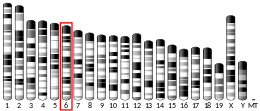FIGLA
Folliculogenesis-specific basic helix-loop-helix, also known as factor in the germline alpha (FIGalpha) or transcription factor FIGa, is a protein that in humans is encoded by the FIGLA gene.[5][6] The FIGLA gene is a germ cell-specific transcription factor preferentially expressed in oocytes that can be found on human chromosome 2p13.3.
Function
[edit]This gene encodes a protein that functions in postnatal oocyte-specific gene expression. The protein is a basic helix-loop-helix transcription factor that regulates multiple oocyte-specific genes, including genes involved in folliculogenesis, oocyte differentiation, and those that encode the zona pellucida.[5] FIGLA is related to the zona pellucida genes ZP1, ZP2, and ZP3.
Clinical significance
[edit]Mutation in the FIGLA gene are associated with premature ovarian failure.[7] Premature ovarian failure is a genetic disorder that leads to hypergonadotropic ovarian failure and infertility. It is believed that premature ovarian failure in humans is caused by FIGLA haploninsuffciency, which disrupts the formation of the primordial follicles.[7][8] This was observed in FIGLA mice knockouts which had diminished follicular endowment and accelerated oocyte loss throughout their reproductive life span.[7][8] Women with mutations in their FIGLA were shown to have a form of premature ovarian failure.[7][8] As well as the failure to form primordial follicles, knockout mice also lacked zona pellucida genes Zp1, Zp2, and ZP3 expression.[8]
References
[edit]- ^ a b c GRCh38: Ensembl release 89: ENSG00000183733 – Ensembl, May 2017
- ^ a b c GRCm38: Ensembl release 89: ENSMUSG00000030001 – Ensembl, May 2017
- ^ "Human PubMed Reference:". National Center for Biotechnology Information, U.S. National Library of Medicine.
- ^ "Mouse PubMed Reference:". National Center for Biotechnology Information, U.S. National Library of Medicine.
- ^ a b "Entrez Gene: folliculogenesis specific basic helix-loop-helix".
- ^ Huntriss J, Gosden R, Hinkins M, Oliver B, Miller D, Rutherford AJ, Picton HM (December 2002). "Isolation, characterization and expression of the human Factor In the Germline alpha (FIGLA) gene in ovarian follicles and oocytes". Molecular Human Reproduction. 8 (12): 1087–95. doi:10.1093/molehr/8.12.1087. PMID 12468641.
- ^ a b c d Zhao H, Chen ZJ, Qin Y, Shi Y, Wang S, Choi Y, Simpson JL, Rajkovic A (June 2008). "Transcription factor FIGLA is mutated in patients with premature ovarian failure". American Journal of Human Genetics. 82 (6): 1342–8. doi:10.1016/j.ajhg.2008.04.018. PMC 2427265. PMID 18499083.
- ^ a b c d Fowler PA, Flannigan S, Mathers A, Gillanders K, Lea RG, Wood MJ, Maheshwari A, Bhattacharya S, Collie-Duguid ES, Baker PJ, Monteiro A, O'Shaughnessy PJ (April 2009). "Gene expression analysis of human fetal ovarian primordial follicle formation". The Journal of Clinical Endocrinology and Metabolism. 94 (4): 1427–35. doi:10.1210/jc.2008-2619. PMID 19258411.
Further reading
[edit]- Miyamoto T, Sengoku K, Takuma N, Hasuike S, Hayashi H, Yamauchi T, Yamashita T, Ishikawa M (November 2002). "Isolation and expression analysis of the testis-specific gene, STRA8, stimulated by retinoic acid gene 8". Journal of Assisted Reproduction and Genetics. 19 (11): 531–5. doi:10.1023/A:1020963919596. PMC 3455343. PMID 12489526.
- Suzumori N, Pangas SA, Rajkovic A (2007). "Candidate genes for premature ovarian failure". Current Medicinal Chemistry. 14 (3): 353–7. doi:10.2174/092986707779941087. PMID 17305537.
- Törmälä RM, Jääskeläinen M, Lakkakorpi J, Liakka A, Tapanainen JS, Vaskivuo TE (July 2008). "Zona pellucida components are present in human fetal ovary before follicle formation" (PDF). Molecular and Cellular Endocrinology. 289 (1–2): 10–5. doi:10.1016/j.mce.2008.01.029. PMID 18502569. S2CID 3455166.
- Zhao H, Chen ZJ, Qin Y, Shi Y, Wang S, Choi Y, Simpson JL, Rajkovic A (June 2008). "Transcription factor FIGLA is mutated in patients with premature ovarian failure". American Journal of Human Genetics. 82 (6): 1342–8. doi:10.1016/j.ajhg.2008.04.018. PMC 2427265. PMID 18499083.
- Pangas SA, Rajkovic A (2006). "Transcriptional regulation of early oogenesis: in search of masters". Human Reproduction Update. 12 (1): 65–76. doi:10.1093/humupd/dmi033. PMID 16143663.
- van Dooren MF, Bertoli-Avellab AM, Oldenburg RA (August 2009). "Premature ovarian failure and gene polymorphisms". Current Opinion in Obstetrics and Gynecology. 21 (4): 313–7. doi:10.1097/gco.0b013e32832e0813. PMID 19610175. S2CID 35641655.
- Bayne RA, Martins da Silva SJ, Anderson RA (June 2004). "Increased expression of the FIGLA transcription factor is associated with primordial follicle formation in the human fetal ovary". Molecular Human Reproduction. 10 (6): 373–81. doi:10.1093/molehr/gah056. PMID 15044608.




